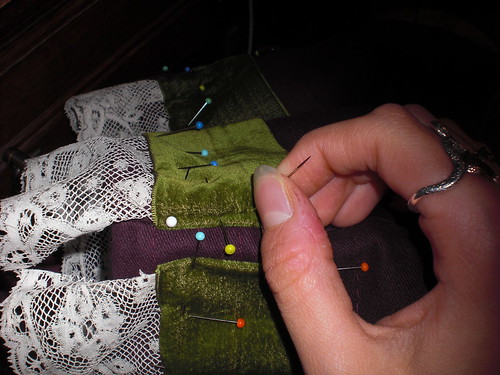When I told my family that I was going to see
Richard III, my dad remarked that he thought the play would be in French. I was quick to dissuade him of that idea; after all,
The Merry Wives of Windsor production that I saw in Belgium four years ago was in English.
Tuesday night, I arrived at the Nouvel Olympia ready to enjoy an evening of beautiful Shakespearian English. An usher handed me a programme and my eyes fell immediately on the words: "
traduction Jean-Michel Deprats." In a very un-French moment, I laughed out loud and shook my head. This was the first surprise of the evening, but not the last.
After taking my seat (in almost the last row of the very full audience), I prepared to hear the famous lines "Now is the winter of our discontent..." (but in French, of course). Before the play began, however, I was able to examine the stage layout. It consisted of two elevated floors, one upstage and one downstage, separated by a space of approximately 9 feet. The floors were both higher up in the upper-left-hand corner, and then sloped to a lower elevation at the lower-right-hand corner. A narrow bridge, perhaps five feet wide, connected the two floors near the right-hand wing. In between the floors, in the space underneath, a small area with slats like a cloister could be seen.
At last the lights went down. Soon the sounds of a battle could be heard, and then a grainy video of a battle scene (stylized and animated) flashed onto each of the floors. The introduction before Richard entered served as a good predictor for the rest of the play, as video and music were both frequently used during the production -- often in scene transitions, but sometimes during scenes as well.
After a few minutes of the video, Richard (played by David Ayala) came out on stage, swaggering, flask in hand. He did not have the famous hunchback, but instead various medical accessories like a knee brace, a wrist brace, and ugly scars on his arm. Outfitted in a leather jacket and a sneer, he appeared more motorcycle hoodlum than royal prince. His acting was impeccable thoughout the entire play (three and a half hours, including a brief intermission), matched only by Buckingham (Alex Selmane). Those two schemed, plotted, and slaughterd their way through the play.
While the acting could not have been better, the post-modern use of props, video, and music could be a bit disconcerting at times. Richard used his cell phone to take pictures of his court frequently, and at each execution, his henchmen took photos of the victims. The picture of the victim then flashed across the floors, an image of death. While the idea of Richard and others taking photos provided some much-needed comic relief, it felt over-used by the end, as did the nearly incessant string music. Occasionally it seemed that the use of violin, for example, served a deliberate attempt to increase suspense where suspense and horror already existed.
The sparse set-up of the stage -- which had only one piece of furniture, a reclining chair that served as a throne -- was similar to the costuming, which focused on dark and somber garments. All three female leads wore floor-length dresses, mostly in grey or black (with the exception of Lady Anne and Queen Elizabeth's celebratory dresses). While the female costumes were old-fashioned aesthically, the rest of the cast dressed in fairly modern clothing, including contemporary military uniforms for Richard's armed forces.
The most sensorily overwhelming scene came at the end, right before the final battle (in this production, only two people were on stage during that battle: Richard and the man who killed him). In this second-to-last scene, Richard lay writhing on one of the floors of the stage, clearly thinking of what he had done, while Lady Anne and the two sons of Edward IV came onstage, wearing white garments stained with blood, while a creepy, mournful choir-sung song came over the speakers, as a film montage of Richard's victims drifted over the floors.
As for the translation, it was definitely in modern French, not a French version of Elizabethan English (which was all for the best, I'm sure). I found it fairly easy to understand; it was harder to keep the characters straight as many of them dressed alike and I'd found
the synopsis of this play somewhat hard to follow as well.
I'd give this play 4 out of 5 stars, with the star lost for overdone post-modern machinations. Judging from the commentary of the French people sitting around me, they would probably give the play 4.5 out of 5 (no perfect score is possible in France).
Two interesting cultural notes: firstly, no one seemed irritated when I had scooch past them to get to my seat -- no eye-rolling, no sighing, just "
Je vous en prie" when I murmured "
Pardon, merci." Secondly, while the cast received tumultuous applause (and a "Brava!" from a woman seated behind me) and came forward to bow at least four times, it was not a standing ovation. Standing ovations are
de rigeur in the States; if a production, be it a play or symphony, is good, then the patrons generally give the performers a standing ovation. I think here standing ovations are reserved for the truly extraordinary. That is not to say that the play wasn't excellent, or that the audience didn't like it, but rather that a standing ovation is not something that every performance warrants.




